
Bordeaux is a city on the river Garonne in the Gironde department, southwestern France. A port city, it is the capital of the Nouvelle-Aquitaine region, as well as the prefecture of the Gironde department. Its inhabitants are called "Bordelais" (masculine) or "Bordelaises" (feminine). The term "Bordelais" may also refer to the city and its surrounding region.

The Place de la Concorde is one of the major public squares in Paris, France. Measuring 7.6 ha in area, it is the largest square in the French capital. It is located in the city's eighth arrondissement, at the eastern end of the Champs-Élysées.

Palace of Fontainebleau, located 55 kilometers southeast of the center of Paris, in the commune of Fontainebleau, is one of the largest French royal châteaux. It served as a hunting lodge and summer residence for many of the French monarchs, including Louis VII, Francis I, Henry II, Louis-Philippe, Napoleon Bonaparte and Napoleon III. Though the monarchs only resided there for a few months of the year, they gradually transformed it into a genuine palace, filled with art and decoration. It became a national museum in 1927 and was designated a UNESCO World Heritage Site in 1981 for its unique architecture and historical importance.
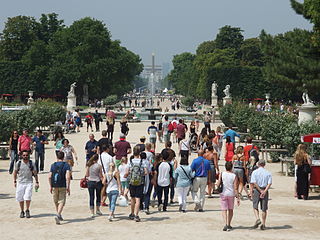
The Tuileries Garden is a public garden between the Louvre and the Place de la Concorde in the 1st arrondissement of Paris, France. Created by Catherine de' Medici as the garden of the Tuileries Palace in 1564, it was opened to the public in 1667 and became a public park after the French Revolution. Since the 19th century, it has been a place for Parisians to celebrate, meet, stroll and relax. During the 2024 Summer Olympics and Paralympics, it was the site of the Olympic and Paralympic cauldron.

Ange-Jacques Gabriel was the principal architect of King Louis XV of France. His major works included the Place de la Concorde, the École Militaire, and the Petit Trianon and opera theater at the Palace of Versailles. His style was a careful balance between French Baroque architecture and French neoclassicism.

Jacques Ignace Hittorff or, in German, Jakob Ignaz Hittorff was a German-born French architect who combined advanced structural use of new materials, notably cast iron, with conservative Beaux-Arts classicism in a career that spanned the decades from the Restoration to the Second Empire.

The Louis XV style or Louis Quinze is a style of architecture and decorative arts which appeared during the reign of Louis XV. From 1710 until about 1730, a period known as the Régence, it was largely an extension of the Louis XIV style of his great-grandfather and predecessor, Louis XIV. From about 1730 until about 1750, it became more original, decorative and exuberant, in what was known as the Rocaille style, under the influence of the King's mistress, Madame de Pompadour. It marked the beginning of the European Rococo movement. From 1750 until the King's death in 1774, it became more sober, ordered, and began to show the influences of Neoclassicism.

The Place Stanislas is a large pedestrianised square in the French city of Nancy, in the Lorraine historic region. Built between 1752 and 1756 on the orders of Stanislaus I, the square is one of the oldest examples of an architecturally consistent and monumental public square, and is an excellent example of 18th-century urban architecture. Since 1983, the architectural ensemble comprising the Place Stanislas, the extension of its axis, the Place de la Carrière and the Place d'Alliance, has been a UNESCO World Heritage Site.

Jacques Gabriel (1667–1742) was a French architect, the father of the famous Ange-Jacques Gabriel. Jacques Gabriel was a designer, painter and architect of the 17th and 18th centuries and one of the most prominent designers of the Palace of Versailles in his lifetime. For his unique creativity and selflessness, he was always attended by Louis XIV and eventually became a trusted advisor to the monarch. He made important contributions to him during his years of service of which the construction of the Palace of Versailles was the most important.

French Baroque architecture, usually called French classicism, was a style of architecture during the reigns of Louis XIII (1610–1643), Louis XIV (1643–1715) and Louis XV (1715–1774). It was preceded by French Renaissance architecture and Mannerism and was followed in the second half of the 18th century by French Neoclassical architecture. The style was originally inspired by the Italian Baroque architecture style, but, particularly under Louis XIV, it gave greater emphasis to regularity, the colossal order of façades, and the use of colonnades and cupolas, to symbolize the power and grandeur of the King. Notable examples of the style include the Grand Trianon of the Palace of Versailles, and the dome of Les Invalides in Paris. In the final years of Louis XIV and the reign of Louis XV, the colossal orders gradually disappeared, the style became lighter and saw the introduction of wrought iron decoration in rocaille designs. The period also saw the introduction of monumental urban squares in Paris and other cities, notably Place Vendôme and the Place de la Concorde. The style profoundly influenced 18th-century secular architecture throughout Europe; the Palace of Versailles and the French formal garden were copied by other courts all over Europe.
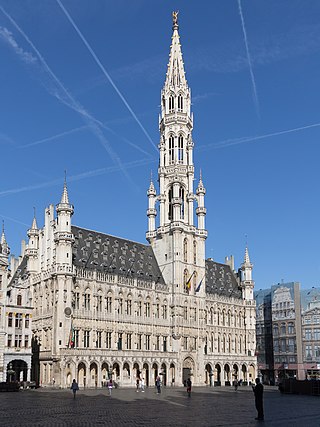
The Town Hall of the City of Brussels is a landmark building and the seat of the City of Brussels municipality of Brussels, Belgium. It is located on the south side of the famous Grand-Place/Grote Markt, opposite the neo-Gothic King's House or Bread House building, housing the Brussels City Museum.
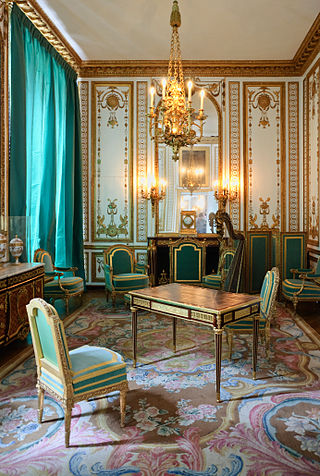
Louis XVI style, also called Louis Seize, is a style of architecture, furniture, decoration and art which developed in France during the 19-year reign of Louis XVI (1774–1792), just before the French Revolution. It saw the final phase of the Baroque style as well as the birth of French Neoclassicism. The style was a reaction against the elaborate ornament of the preceding Baroque period. It was inspired in part by the discoveries of Ancient Roman paintings, sculpture and architecture in Herculaneum and Pompeii. Its features included the straight column, the simplicity of the post-and-lintel, the architrave of the Greek temple. It also expressed the Rousseau-inspired values of returning to nature and the view of nature as an idealized and wild but still orderly and inherently worthy model for the arts to follow.

The Hôtel de la Marine, also known (formerly) as the Hôtel du Garde-Meuble, is an historic building on the Place de la Concorde in Paris, just east of Rue Royale. It was designed by the architect Ange-Jacques Gabriel and built between 1757 and 1774 on the newly created square first called Place Louis XV. The identical building across the street, constructed at the same time, now houses the Hôtel de Crillon and the Automobile Club of France.
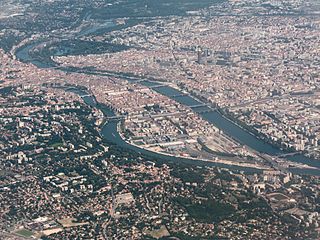
The Presqu'île is the central part of the City of Lyon, France. Extending from the foot of the Croix-Rousse hill in the north to the confluence of the Rhône and the Saône rivers in the south, it has a preponderance of cafés, restaurants, luxury shops, department stores, banks, government buildings and cultural institutions.
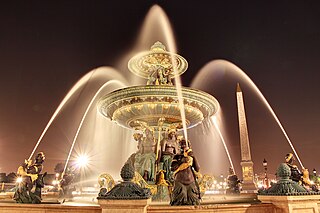
The Fontaines de la Concorde are two monumental fountains located in the Place de la Concorde in the center of Paris. They were designed by Jacques Ignace Hittorff, and completed in 1840 during the reign of King Louis-Philippe. The south fountain commemorates the maritime commerce and industry of France, and the north fountain commemorates navigation and commerce on the rivers of France.
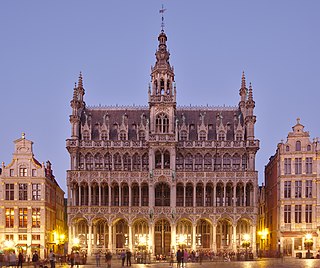
The Brussels City Museum is a municipal museum on the Grand-Place/Grote Markt of Brussels, Belgium. Conceived in 1860 and inaugurated in 1887, it is dedicated to the history and folklore of the City of Brussels from its foundation into modern times, which it presents through paintings, sculptures, tapestries, engravings, photos and models, including a notable scale-representation of the town during the Middle Ages.
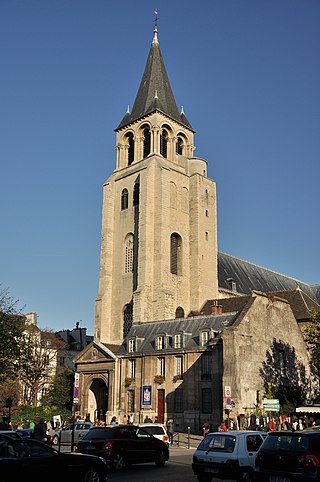
The city of Paris has notable examples of architecture of every period, from the Middle Ages to the 21st century. It was the birthplace of the Gothic style, and has important monuments of the French Renaissance, Classical revival, the Flamboyant style of the reign of Napoleon III, the Belle Époque, and the Art Nouveau style. The great Exposition Universelle (1889) and 1900 added Paris landmarks, including the Eiffel Tower and Grand Palais. In the 20th century, the Art Deco style of architecture first appeared in Paris, and Paris architects also influenced the postmodern architecture of the second half of the century.

Neoclassicism is a movement in architecture, design and the arts which emerged in France in the 1740s and became dominant in France between about 1760 to 1830. It emerged as a reaction to the frivolity and excessive ornament of the baroque and rococo styles. In architecture it featured sobriety, straight lines, and forms, such as the pediment and colonnade, based on Ancient Greek and Roman models. In painting it featured heroism and sacrifice in the time of the ancient Romans and Greeks. It began late in the reign of Louis XV, became dominant under Louis XVI, and continued through the French Revolution, the French Directory, and the reign of Napoleon Bonaparte, and the Bourbon Restoration until 1830, when it was gradually replaced as the dominant style by romanticism and eclecticism.

The Port de la Lune is the name given to the harbour of Bordeaux, dating to the Middle Ages, because of the shape of the river crossing the city. It is represented by a crescent on the coat of arms of Bordeaux, and by three interlaced crescents in the logotype of the municipality.

The Arc Héré or Porte Héré is a triumphal arch located in the city of Nancy, France, on the north side of the Place Stanislas. It was designed by Emmanuel Héré de Corny to honor the French king Louis XV and was built between 1752 and 1755. Its architecture is inspired by the Arch of Septimius Severus in Rome. The Arc replaced an older royal gate constructed under the rule of Louis XIV; three bas reliefs from the old gate are featured on the Arc.





















